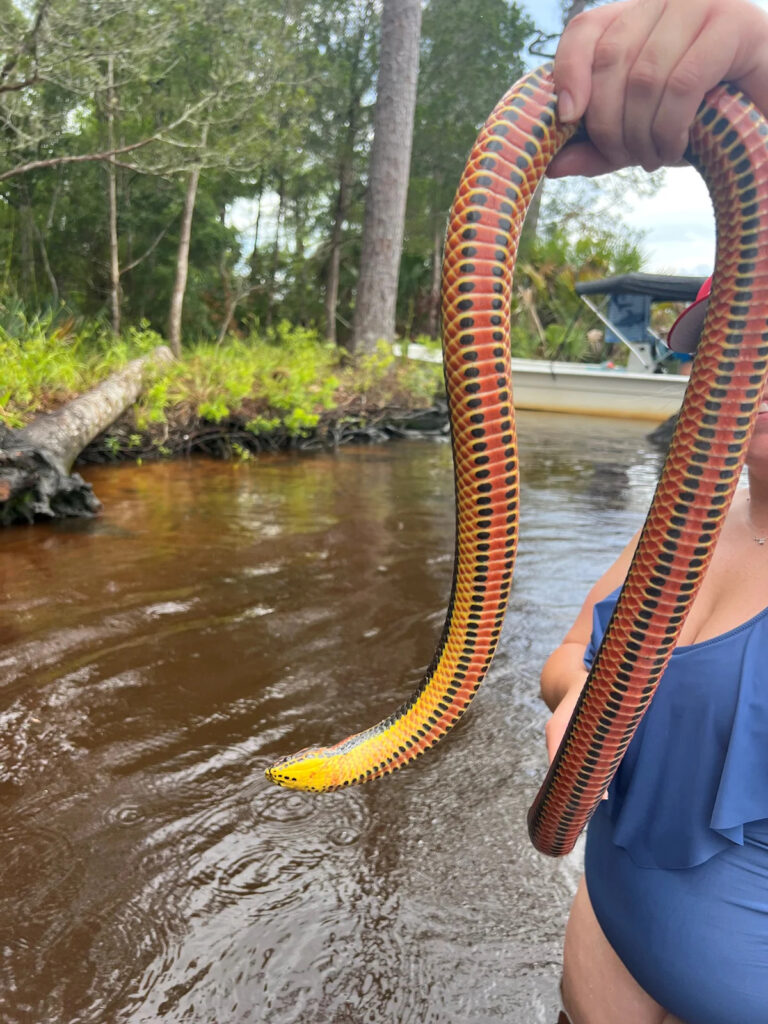The Florida Fish and Wildlife Conservation Commission has received at least a dozen credible rainbow snake sightings since it sought the public’s assistance in documenting the elusive reptiles.
FWC research scientist Kevin Enge told USA TODAY over email on Friday, Aug. 22, that the commission received approximately 30 reports since its news release was put out. However, out of those, only 12 were credible, and only eight had photos that allowed confirmation of the species. Enge said more reports were also received, but they “were not rainbow snakes based on photos, descriptions, or locations.”
While two reports were of rainbow snakes on the same driveway at night in a new subdivision in Yulee, Nassau County, albeit in different months, three other reports were from Wakulla County, with one of them being at the spring-fed Wakulla River boat launch on U.S. Hwy 98, a FWC environmental DNA sampling site.
Enge said the most interesting rainbow snake sighting was under a boat motor on a sand bar on the lower Ochlockonee River, near Sopchoppy, about 35 miles south of Tallahassee.
Another sighting occurred in a small tributary of the Escambia River near Century in Escambia County, about 200 miles west of Tallahassee. Florida resident Roy Gebhard spotted the snake at a bridge crossing, which also happens to be a popular party spot, prompting him to move it downstream away from people, he told FWC.
Gebhard noted the animal did not attempt to bite him and was possibly hunting for eels in the area.
See pictures of rainbow snake sightings in Florida
85782112007
Are rainbow snakes under threat?
The elusive rainbow snake, scientifically known as Farancia erytrogramma, is a nonvenomous species whose population has declined in recent decades, according to the FWC. Their populations have been affected by habitat loss and declining food sources. Rainbow snakes primarily feed on American eels, a prey species that has also declined in Florida waters due to overfishing and dams, according to the wildlife commission.
Enge told USA TODAY the common rainbow snake is found along streams and in tidal marshes in the Coastal Plain from southeastern Maryland to southeastern Louisiana. The snake is locally common in some streams from Virginia to Georgia along the Atlantic. However, snakes in the northern part of their range have been dying from snake fungal disease, raising concerns about the species’ long-term survival.
The rainbow snake was officially last documented in 2020, FWC spokesperson Jonathan Veach told USA TODAY on Aug. 18. However, Veach added that other rainbow snake sightings in Florida since 2020 were possible, but either “weren’t reported, or we never learned of them.”
Rainbow snake
Rainbow snake features
With bright and colorful scales, rainbow snakes are visually striking and can easily be identified. They are usually an iridescent black or violet-blue and have three red stripes along their back, with their lip and chin scales yellow, marked with violet spots, according to the commission. Adult snakes typically reach 3 to 4 feet in length.
These semiaquatic reptiles are usually “found in or near water, including rivers, springs and brackish marshes,” the commission says, adding that a south Florida subspecies was historically found in Fisheating Creek in Glades County, more than 150 miles south of the nearest known population in Lake County. However, that species has not been documented since 1952, and researchers are hoping to confirm their existence.
Need a break? Play the USA TODAY Daily Crossword Puzzle

The Florida Fish and Wildlife Conservation Commission is seeking the public’s assistance in documenting the super rare rainbow snake, last spotted in February 2020.
How to report a rainbow snake sighting
Enge said that while rainbow snake sightings are sometimes posted on social media, “There has been no previous effort to solicit sightings from the public.”
“Scientists rarely find rainbow snakes in Florida, but there are a lot of people fishing, boating, and swimming in our streams that can serve as our eyes,” Enge said. “We need help from Floridians and visitors to better understand where rainbow snakes still occur in the state. Every sighting report gives us valuable data about their current distribution and helps us assess the health of the species in Florida.”
Rainbow snakes are highly secretive and are rarely seen. They can occasionally be found crossing roads between bodies of water, usually on rainy nights, according to the University of Florida’s Florida Museum.
“Swimmers and divers occasionally report seeing them slowly crawling along the bottom of clear, spring-fed rivers,” the museum said.
The FWC is requesting those who spot a rainbow snake to report the sighting to the commission online.
“Photographs are especially helpful in confirming sightings and can be included when you submit your sighting online,” the commission said. “By sharing sightings, the public can play an important role in conserving this unique species.”
How many people are bitten by snakes per year?
While rainbow snakes are not venomous, snake bites are not uncommon in the United States, with approximately 7,000 to 8,000 people bitten by venomous snakes across the country annually, according to the Centers for Disease Control and Prevention.
About five people die from venomous snake bites in the United States each year, the CDC says, warning that the number would be higher if those bitten did not seek medical treatment.
Saman Shafiq is a trending news reporter for USA TODAY. Reach her at sshafiq@gannett.com and follow her on X and Instagram @saman_shafiq7.
This article originally appeared on USA TODAY: See pictures of Florida’s secretive, rare rainbow snake

